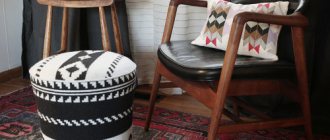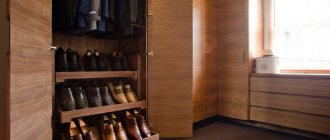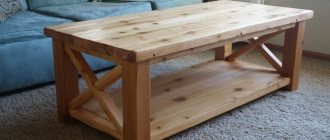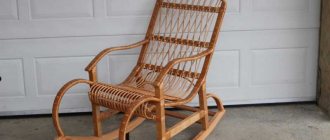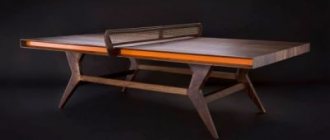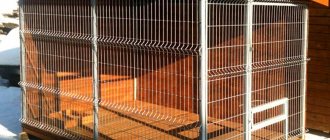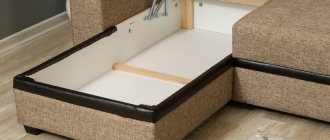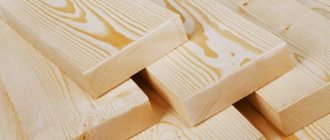An ottoman is a cute and functional interior element. It perfectly complements the furniture composition, creates a stylish space and brings special comfort to the room. The ottoman easily copes with a variety of roles that he has to play. It can act as a chair or bench, footrest, or storage space. If you want to make the room cute and cozy, an ottoman is exactly the item that will help you cope with this task with ease. And if your budget does not allow for such expenses, but you really want to get a comfortable seat, build an ottoman with your own hands using simple improvised means.
Types of ottomans
Poufs can be of completely different shapes - rectangular, square, round and triangular.
- The upholstery for soft stools in production is also used in different ways - jacquard, velor, tapestry, leatherette, flock, microfiber, chenille.
- At home, you can use used fabric: Old curtains, blankets, jackets, etc.
Models are made with legs, on wheels or without them. The sizes can be completely different - from miniature ottomans to large and wide full-fledged “chairs” or “sofas” without a back.
Such upholstered furniture can be used anywhere. The pouf is placed in the living room next to the sofa so that you can comfortably stretch your legs while relaxing. Or in the hallway to sit down while putting on your shoes. In the kitchen or in any other room - for additional seating.
Poufs made with your own hands in the country are irreplaceable. It is not cost-effective to furnish a small garden house with new furniture, so ideas from improvised means are used.
Design selection
The choice of design depends on the room for which the pouf is intended. So, for a child’s room, it is preferable to choose frameless models. Whereas for the hallway and living room it is advisable to choose poufs with a frame, although in both cases the choice can be individual.
Ottoman-bag
To make such an ottoman, you need the following: thick and lining fabric; zippers 40 and 60 cm; scissors, polystyrene foam balls as filler. An example is shown in Fig. 1.
- On the fabric, using chalk, you need to draw the details of the bag, according to a previously made pattern (Fig. 1).
- All parts must be connected using a sewing machine. A zipper of 40 cm in size must be sewn into a bag made of lining fabric, and a zipper measuring 60 cm into a bag made of main fabric. The parts of the bag must be connected in the following sequence: fabric of petals, zipper, top, bottom.
- The finished bags need to be turned inside out and inserted into each other, aligning the zippers.
- Fill the bag with filler and give the bag the desired shape.
Knitted
Such an ottoman can be made from an old unnecessary sweater that no one has worn for a long time or knitted or crocheted. When choosing knitting, the best and fastest option is garter stitch. To create a knitted ottoman you will need: 800-900 grams of yarn, thick knitting needles, foam rubber or polystyrene foam as a filler.
What room design to choose for boys, see the article Design of a children's room for two boys.
You need to knit a long piece of yarn, then connect the side and top parts with a hook. Through the open part of the ottoman, you need to fill it with filling and sew it up.
Round
A round ottoman can be made from a car tire. It is advisable that the tire be mounted on a disk, so the structure will be more durable. In addition to the tire itself, to make an ottoman you will need: plywood, screws, glue and rope.
Making an ottoman is quite simple - just cut out two circles from plywood corresponding to the size of the tire and use screws to attach them to the top and bottom of the product. Then you need to glue the rope, winding it in a spiral from the center to the edges over the entire surface of the pouf.
Square
You can use a regular box or wooden box as a frame for a square ottoman. Making such a pouf is very simple.
- A square corresponding to the size of the box is cut out of plywood and attached to it with screws.
- Next, all sides of the pouf should be covered with thick foam rubber. In addition to foam rubber, you need to add padding polyester to the seat.
- Cover the resulting structure with thick fabric and secure with a stapler or decorative nails.
Find out how to lay artificial design in an original and beautiful way from the source Unique apartment design using artificial stone.
With backrest
Making such an ottoman is quite simple. It can be made from thick fabric or eco-leather. The parts are cut out with seam allowances, and then simply sewn together; a zipper needs to be sewn at the bottom of the ottoman (Fig. 2). The finished pouf needs to be turned out and filled with filler - polystyrene foam.
Banquette
Banquettes are most often used in the bedroom or hallway. Anyone, even a beginner, can make such a piece of furniture. And this can be done from scrap materials, for example, from an old coffee table that sits idle in the closet collecting dust. In addition to the table itself, to make a bench you will need the following tools: pliers, foam rubber, upholstery and lining fabric, scissors, glue, hammer, stapler, tape measure and screwdriver.
- You need to unscrew the legs from the table.
- The foam rubber must be measured according to the length and width of the tabletop and the required piece must be cut in, leaving small allowances on each side.
- The finished piece of foam rubber must be laid out on the floor, then the surface of the tabletop should be covered with glue and turned over onto the foam rubber strictly along the marked lines.
- It is necessary to cut the lining according to the size of the tabletop, preferably non-woven material. It is important not to forget about allowances. You need to apply glue to the foam rubber and glue a finished piece of non-woven fabric to it.
- Next, measure and cut the required piece of fabric for the upholstery. The allowances on the upholstery fabric should be large, so it will be easier to stretch it onto the tabletop. The finished piece should be laid out face down on a flat horizontal surface. On top of the fabric you need to carefully place the tabletop with the foam facing down. The fabric allowances must be folded to the underside of the tabletop and secured with a stapler.
- You need to cut the lining fabric according to the size of the tabletop, not forgetting about the allowances. This fabric needs to be attached to the bottom of the tabletop, folding the seam allowances inwards.
- In the places for the legs you need to make small holes in the fabric and screw the legs back.
- The finished banquette needs to be turned over and placed in the hallway or bedroom.
Pouf hippopotamus
To make this pouf you will need: a piece of thick fabric, scissors, chalk, cardboard for making patterns, padding polyester
- On the fabric you need to lay out all the details of the hippopotamus, cut out on cardboard according to the diagram presented below (Fig. 3).
- All details need to be outlined with chalk and then cut out, not forgetting the seam allowances.
- Connect all the parts together using a sewing machine. At the bottom of the hippo you need to sew a long zipper.
- The finished hippopotamus needs to be turned out and stuffed with padding polyester.
- The eyes can be made from large black buttons or from pieces of leather.
Folding
To make such a pouf you will need: 2 large thick pieces of foam rubber, a knife, scissors, a pencil, paper, fabric, Velcro tape.
How to do:
- On paper you need to make 3 patterns - rectangles, the dimensions of which are: 70x90 cm, 22x70 cm, 22x90 cm.
- You need to put a pattern corresponding to dimensions 70×90 on the foam rubber and cut out 2 identical pieces.
- It is necessary to cut pieces of the fabric of the following sizes: 72×92 cm - 2 pieces (C, C1); 24x72 cm - 2 pieces (A, A1), 22x92 cm - 4 pieces (D, D1, D2, D3), and then all the pieces according to one option: 44x72 cm (B); 72x182 cm (E). To fasten the entire structure, you need to cut four pieces of tape, measuring 541x4 cm.
- All parts must be joined together according to the allowances, then foam pillows must be inserted into the ready-made covers.
Ottoman with drawer
In order to make a pouf with a drawer you will need: plywood, wooden blocks, foam rubber, paint, a screwdriver, a hammer, a stapler, a tape measure, and piano hinges.
- It is necessary to cut out and assemble the frame, stand and cover.
- The frame must be painted from the inside and left to dry.
- Using a screwdriver, screws and piano hinges, the lid and frame are connected to each other.
- The finished box is covered with foam rubber and covered with fabric, and then attached to a stand, which can also be pre-painted.
You can make beautiful pillows for your sofa yourself! See ideas in the article Making decorative pillows with your own hands.
Tools for creating an ottoman
To make your own pouf at home, you need to prepare the following tools:
- Screwdriver with different attachments;
- Self-tapping screws and self-tapping screws;
- Glue gun;
- Sandpaper;
- Jigsaw or saw;
- Furniture stapler.
Materials for homemade products can be very different - plastic bottles, old boxes and pallets, sheets of plywood, fiberboard, plastic containers and others.
How to sew a pouf or bean bag chair with your own hands
Frameless poufs are in high demand because they have many advantages. They are spectacular, lightweight, mobile, take up minimal space and can adapt to the shape of the body, so the load is distributed evenly. Making a bean bag chair yourself is quite possible. To do this, you just need to download the drawing, cut out the parts, stitch the edges and fill the product with polyurethane ball filler.
Ottoman from a drawer
A wonderful stool on wheels with a soft seat cover can be made for a summer house or garden, or even for the home (in a hallway with a marine theme, for example).
To work, in addition to tools, you will need one wooden box (after storing food), four wheels, canopies for the lid, a piece of plywood, white paint for wooden products, a piece of foam rubber and padding polyester, and a piece from an old curtain.
Work process:
- The box must be prepared: cleaned of dirt and sanded. If there are protruding nails, remove them with a pry and carefully nail them again.
- Attach four wheels to the bottom with self-tapping screws (purchase in a store or unscrew from an unnecessary item).
- Make two holes on the two smaller sides with the same distance from each other. This is for rope handles.
- Take a can of white paint and paint the outside of the box (you don’t have to touch the bottom and inside).
- Leave the product to dry.
- Thread a piece of rope through the side holes and staple it inside.
- From plywood (used or new furniture) cut a rectangle of the size corresponding to the box - for the lid.
- Glue a piece of foam rubber onto the plywood, cut off the excess.
- Take upholstery fabric - a piece of curtain and wrap it around the future seat cover, securing the edges from the inside with a stapler or glue.
- For the inner bag, make a pattern in the shape of a three-dimensional cross from lining fabric (you can use almost any fabric or upholstery fabric from which the lid is made), taking measurements first and leaving 1.5 centimeters at the edges for hemming.
- Sew all four corners and turn the bag right side out. Place it in the box and secure it around the edges with a stapler.
- Cover another piece of plywood identical in size with fabric and staple it to the inside of the pouf lid.
- Secure the mechanism for raising the seat: screw small canopies onto the box and plywood with foam rubber using small screws. Poof is ready!
Various small items are stored in the ottoman. The presence of wheels allows you to easily move the pouf throughout the house or throughout the garden terrace.
How to make soft frameless poufs
On the Internet you can find the necessary drawings and diagrams, according to which it is easy to make a frameless soft pouf for your room yourself. Such furniture is perfect for both a nursery and a living room; the main thing is to properly think through its design and decorative design.
For a nursery, it is best to use thick fabric, such as jacquard, as a material. Not every fabric can withstand daily testing.
A pouf for a nursery is made in the form of a soft toy, then it arouses more interest in the baby and fits perfectly into the design of the room.
Furniture for the living room should be more classic or consistent in the general style, for example, shabby chic, Provence or loft.
"Octahedron"
This piece of furniture is sewn from scraps. To make it you will need:
- woven material;
- sewing machine;
- thread and needle;
- filler.
First, you need to cut out a blank from thick cardboard or any other paper. It is made in the shape of a triangle with one sharp end cut off.
The advantage of the “octahedron” in question is that it can be sewn from patches of different colors. In this case, the designer's capabilities are limited only by his imagination. In addition to differences in color palette, individual patches may also differ in texture.
When all the elements are connected to each other, the overall structure will look like a ball. Before you start stuffing the pouf, the tops of the stitched sections need to be slightly bent.
Without filler, the product will not hold its shape. It uses padding polyester and foam rubber; you can simply fill it with sawdust, but then you will need to build an additional rough cover made of thick fabric, which will prevent particles from falling out.
The remaining hole on top is covered with a small piece of fabric.
The pouf bag consists of two covers. This is one of the simplest models that you can make at home yourself.
The pear-shaped shape is most common because it gives maximum comfort and convenience to a person.
To sew the outer cover, durable fabric is selected. The inner bag is best made of synthetic material.
To work you will need:
- sewing machine or needle and thread;
- lightning;
- textile;
- filler.
For the pattern you will need a ruler, pencil or chalk, and scissors.
The outer cover is sewn from six wedges, and a zipper is installed between the two. After the filler gets inside, the pouf takes on the desired shape.
Such easy-to-make furniture can have other shapes.
Bottle ottoman
To quickly and easily make a pouf for a country house, you need to take 23 empty plastic bottles. Connect them together using tape (in other words, wrap them).
- Cut two circles from a sheet of plywood with a diameter corresponding approximately to the diameter of the bottles assembled together (measured from below).
- Glue two circles to the bottles on top and bottom, secure with small screws.
- From old artificial leather, cut out two circles (slightly larger than plywood) and a rectangle around the circumference of the bottles. Sew a cover from the pattern.
If you don’t have a sewing machine, you can baste it by hand or glue the material to the base. That's all! The country ottoman is ready.
Anyone who doesn’t have enough chairs while relaxing in the garden at a barbecue can sit on it. Or put an impromptu stool on the terrace in front of the house.
Tools and materials
To make the described piece of furniture with your own hands, you need to have special tools on hand. The list of necessary materials also depends on the scheme the master will follow.
Recently, synthetic fillers have become in demand, but if they cause allergies, you should opt for the wood variety.
Cedar and pine sawdust are praised for their healing effect, but they need to be changed periodically. The main advantage of natural wood filler is its environmental friendliness and the absence of chemical components.
A soft and comfortable pouf is obtained if you use polystyrene foam. Small balls provide the required volume and do not sag over time. You can use lightweight holofiber.
Polyurethane foam is often used as a filler for poufs; it also does not cause allergies and has the desired elasticity.
Even an old blanket can be used to create a pouf. A pillow may be suitable if you plan to make frameless furniture.
Abroad, peas, cereals and even dry grass are widely used as filler.
Regardless of what materials you plan to make the item from, you should have at hand:
- scissors;
- knife;
- construction stapler;
- thread and needle;
- universal glue;
- upholstery fabric;
- filler.
As a rule, the fabric is crocheted, since this tool has more possibilities. The yarn can be either wool or any other, it all depends on the preferences of the designer.
Such a pouf can be used as a separate piece of furniture or as an addition to an ottoman. Lyon brand yarn is good for knitting. It is better to take a darker shade, since dirt will quickly be visible on a light one.
In addition, you will need:
- hook;
- tapestry needles;
- filler;
- plastic bag.
Since the filling of knitted material can come out, the latter should first be placed in a bag, then in a soft bag. A simple pillowcase does the job perfectly.
It is recommended to purchase dense fabric that can withstand constant use. The size of the purchased canvas is at least 1.25 meters.
In addition to the material, you will need:
- lightning;
- measuring tape;
- pins;
- filler.
It is advisable to sew all individual parts together using a sewing machine.
A circle is cut out of the specified amount of fabric, the diameter of which should be 46 centimeters. Also, use scissors to form a rectangle with a length of 142 centimeters and a width of 40 centimeters.
The last thing to cut is a square with sides of 48 centimeters. It is subsequently divided into two halves and a zipper is sewn on. Only after this a circle is made from the square using a ready-made template.
The rectangle is folded in half on the short side and the circle is sewn on. This creates one wall of the pouf. From the other end the actions are repeated. The result is an attractive round piece of furniture that can decorate any interior. The filler is laid after the cover is completely ready.
Bucket ottoman
An unusual pouf with a soft seat can be made from an ordinary plastic bucket.
To work you will need:
- Large plastic bucket (after mayonnaise or paint);
- Shovel handle;
- Jigsaw or saw;
- Screwdriver and screws;
- Faux fur (formerly plaid);
- Foam rubber and synthetic winterizer - according to the cut;
- PVA carpentry glue.
Process of creation:
- Remove the handle from the bucket and turn the bucket upside down.
- Cut the cutting into 3 parts (approximately 45 cm each).
- Glue the legs inside the bucket at the same distance from each other and secure with screws on the outside.
- Measure the required diameter of the bottom of the bucket and cut a circle from foam rubber. Glue a piece of foam rubber to the bottom of the bucket.
- Cut the required size of padding polyester and wrap it around the bucket (place the fabric on glue).
- From an old blanket (imitation faux fur), cut out a rectangle and a circle (the size of the bucket). Sew a cover and pull it over the bucket.
- Fold the fabric inward from the wrong side.
- Cut out a suitable circle from cardboard, wrap it with any lining fabric and attach it to the inside of the ottoman, covering the empty space of the bucket. Poof is ready!
Small furniture made from scrap materials
Large plastic containers, old chairs and stools, drawers, wooden hanging shelves and even parts of old suitcases can be reborn. In the hands of a person with a designer's mindset, old junk can serve for many years.
Wooden parts of old furniture are an excellent basis for new products. An old TV without a kinescope is also very strong; it can be attached under a shoe rack with a soft seat for the garden.
It’s a shame to throw away old cotton blankets and have nowhere to store them - an excellent basis for soft seats. You need to wrap them tightly in the form of a cylinder, bandage them and place them in zippered cases. It is convenient to sit on them in an upright position (cylinder) and in a “lying” position (roller).
A cable reel is a good base for a homemade pouf. The design can be varied, the lower part of the leg can be left open. It is important to design the “seat” correctly so that the product is comfortable.
From car tires
The most common material for country crafts is “bald” rubber. Many interesting ideas have been developed on how to make an ottoman out of tires. They can be sheathed, wrapped in foam rubber under a cover, or covered with thick twine.
For the transformation you will need a cutter for cutting rubber, a stapler for fastening and attractive material for decoration. The simplest way is to wrap it with wide ribbons; you get a donut-shaped pouf without a seat in the center.
If desired, you can make a lid for it with a soft cushion on top; it is fixed with a screwdriver.
From plastic bottles
The almost weightless model can be easily made from identical plastic bottles. You can always collect the required amount if you buy soft drinks packaged in one sample.
If you keep them in the freezer and then screw them tightly, the heating of the air will make them stronger and expand from the inside.
There are several ways to make an ottoman from plastic containers. Briefly it can be described as follows:
- For a small children's ottoman, 1.5-2 liter bottles are enough, which are tightly wrapped with tape. They should be tightly closed with lids turned to one side. The bottom and top can be made of plywood - this will make the product stronger.
- The workpiece must be wrapped in foam rubber or something soft, such as padding polyester or an old blanket. This will make him more comfortable. Next, the blank of plastic bottles is measured to make an accurate pattern for a cylindrical cover. Finish the covering by making a soft seat.
- A larger ottoman, for adults, can be made from more bottles. The seat must be reliable, so the bottles can be filled with some porous material. For reliability, you can cut out the bottom and top from plywood, providing stiffening ribs from bars fixed at the edges between the bottles.
The design of the seat can be varied at your discretion.
Round ottomans
Homemade ottomans are also made in a round shape from plywood and a flexible fiberboard sheet, fastening all parts using a screwdriver, self-tapping screws and a stapler, and then upholstering them with any fabric. You can attach wheels or legs to the bottom, which can be straight or oblique (three pieces).
If desired, they can be made with an internal drawer and lid, attaching canopies to the frame and seat.
Handmade furniture looks very original, original and creative. By choosing the shape, size and color scheme of the upholstery, you can make a pouf that will suit any interior design of your home or cottage.
Pouf in the form of a barrel
It is clear that making a round pouf with your own hands is easier than its octagonal counterpart. Making a “barrel” is also not complete without chipboard and bars. The corresponding event takes place in stages:
- First you need to make two circles of plywood with a diameter of 40 cm;
- Next, 6-8 bars are attached to one circle to form a kind of chair;
- The next step is to attach the second round disk to the free ends of the legs;
- The round structure is wrapped in flexible cardboard (here it is easier to fasten with a stapler and staples);
- The cardboard facade is wrapped in padding polyester;
- Thick furniture foam rubber is glued to the seat;
- A pattern is made according to the shape and dimensions of the structure;
- Fabric or leather upholstery is made according to the pattern;
- The structure is completed with upholstery and is ready for use.
To the question of how to make an ottoman with your own hands if there is a cat in the house, a simple answer is given - you can cut a hole in the wall of the container so that your pet can get inside the product and live in it. A pouf box is also suitable for this idea.
Photo of a homemade ottoman
Choosing the design and shape of the ottoman
The design of the pouf depends on the interior of the hallway. It should match the rest of the furnishings in color and be the right size. If necessary, the pouf can perform several functions, depending on the chosen model.
Crafting and decorating your home with your own hands is a rewarding experience.
Color
It is better to make the pouffe box the same color as the rest of the furniture in the hallway. The lid can be contrasting, but you need to think about what it could be combined with. Rooms where the legs of the pouf and, for example, the mirror frame are painted in the same shade look interesting. A plain ottoman in the color of the door, walls or floor also looks stylish.
Gray color is very stylish.
If the style of the apartment allows, the pouf can be given a place as a bright accent. In this case, it may not be combined with other pieces of furniture. This solution fits into modern design projects.
With lid and shoe rack
One of the most convenient models is a pouffe with a lid and a shoe stand. The upper part can be made soft or left without a seat; you can sit on it or put a bag on it.
An ottoman with a lid is functional.
Under the lid there is enough space for a minimum set of shoes. You don’t have to buy a separate stand, leaving room for a closet or chest of drawers.
Other models
The simplest and most popular form of pouf is a box. This model is easy to make, has space for storage inside, and does not take up much space. There are corner ottomans, they help save space in the hallway, since the corners usually remain unused.
The pouf cabinet is indispensable in the hallway.
A pouf cabinet is another option for optimal use of space. In this model, the seat is attached to a storage system with drawers or hinged doors. Round and cylindrical poufs also have a hinged lid so that you can put some things inside.
Round pouffe boxes are used for storing things.
If desired, the pouf can be upholstered with soft material or left without a decorative covering. When making such a choice, you need to start from the interior of the hallway.
Non-standard solutions in the manufacture of ottomans
Soft ottomans can be of any shape, even spherical. This will be just a great option for a children's room, which will become one of your child's favorite toys.
The ottoman ball is quite easy to make yourself, for this you will need:
- Sewing machine;
- Threads;
- Needle;
- Scissors;
- High density fabric, two colors;
- Graph paper for drawing up a pattern;
- Polyethylene;
- Silicone filler in the form of balls.
The process of creating a ball ottoman consists of the following stages:
- First of all, you need to make a pattern on graph paper, observing the required dimensions. To make the task easier, use a round object, such as a large inflatable balloon or a lampshade for a floor lamp. Measure its circumference and divide the resulting size in half. Divide this number into 5 parts so that the middle 3 and the outer 2 are the same size. You will get the diameter of the base in the form of a circle and the width of the stripes that make up the spherical cover of the ottoman.
- Transfer the resulting markings to the item you have chosen, starting with the circle-shaped part. Draw the next line below along the pre-calculated strip width.
- Take a plastic bag, cut it along one side and cut off the bottom. Straighten and place on the marks of the first strip, secure the edges with tape. Transfer a quarter strip to polyethylene and cut. Prepare the middle strip piece in the same way. Trace the pieces onto graph paper before cutting.
- Now the details of the ottoman need to be cut out of fabric of two colors, leaving 1 cm for a seam allowance. Sew them into stripes, leaving one side unstitched, and iron them.
- Attach the first strip to the round piece. The ends of the strip must meet exactly with each other. Stitch them and connect the round base to the strip with a seam, leaving 1 cm from the edge.
- Sew a similar piece for the opposite side of the cover and stitch it to the middle strip. At the same time, do not stitch the ends of the middle strip. In the same way, sew the second semicircular piece with a middle stripe and iron the seams.
The case for the ball ottoman is ready, all you have to do is fill it with filling. To make the shape elastic, add small pieces of foam rubber inside. Close the hole with a hidden seam.
A new look at old things: making furniture from clothes
This is not a fairy tale or fantasy; an old sweater can really turn into an original ottoman, not only very comfortable, but also a noticeable element of the interior. Making such a piece of furniture is very simple, because the main condition is an original, bright, beautiful or funny pattern on the sweater that you will use in your work.
So, you will need:
- A sweater that you won’t wear anymore, but it’s a pity to throw it away;
- Scissors;
- Thread and needle;
- Felt;
- Fabric for the cover (lining material is perfect);
- Prostyrene foam for stuffing.
Cut the bottom of the ottoman into a round or square shape from felt. This part will serve as the primary blank. Take the sweater and turn the sleeves inside, sew the remaining holes with an even seam. Sew the felt blank to the bottom of the sweater to create a bag-cover.
Tip: By using solid-colored sweaters with chunky knits like argyle or cable knits, you'll get a stunning, classic-vintage ottoman that will look great in any decor. These knitted patterns are suitable for square and rectangular shapes.
Now you need to prepare a cover made of dense lining fabric for polystyrene foam. If your initial piece of felt is round in shape, then you will need one piece of fabric of the required size (for example, 50 cm wide and 70 cm long), but if you decide to make a square ottoman, then calculate the required dimensions for four parts.
Sew all the pieces together, and leave a hem at the top for the lace, which will tighten the lace after you fill it with padding. You should fill the cover with polystyrene foam after you place it inside the sweater. Pull the lace as tightly as possible so that the filling does not spill out, straighten the sweater and enjoy your new piece of furniture!
Types of poufs
Box-style ottomans are practical and often have storage space inside the frame
Roller ottoman serves as a great design element
There is an abundance of all kinds of pouf models that differ from each other: shape, functionality or application options.
| Model | Characteristics |
| Box | The most common version of an ottoman, which does not take up much free space. |
| It has a small storage system that can fit several pairs of shoes. | |
| It will suit any interior style, as it comes in a variety of colors and is made from many materials. | |
| Cylindrical shape | Models are made on wheels, legs or without a stand at all. |
| They help smooth out corners in the room and, if necessary, in the interior. | |
| They can become the main accent of the hallway if they are made in bright colors or create an unusual room design. | |
| Cabinet | A practical, multifunctional version of the product allows you to sit on it and place all sorts of little things at the same time. |
| A successful model for owners of a large number of shoes, accessories and other small items, it allows you to use the ottoman 100%. | |
| It is made with a miniature table on which a table clock, figurines, a landline telephone or a mirror can find a place. | |
| Angular shape | Allows you to use the corners of the hallway to their full potential. |
| Households will have much more storage space at their disposal. | |
| The model may consist of a system of poufs that together make up a soft, large triangular seat. | |
| Ottoman with drawer | The option is similar to a pouf - a cabinet, but does not include a table. |
| Drawers are located under the seat and create an extensive storage system for various items. | |
| The functional component of the ottoman does not harm the appearance and creates an attractive and elegant decorative element. |
An ottoman with a shelf is both a seat and a convenient storage place for various small items.
The corner ottoman is made in a triangular shape and is a shelf for objects and a seat
Classic-style ottoman for the hallway
Square pouf made of lumber
A stylish and exclusive ottoman can be easily assembled from scrap materials, and you won’t have to buy lumber separately. For loft-style interiors, new fruit boxes are used, made of high-quality material and impregnated with a special antiseptic.
The second box is carefully disassembled into boards and its bottom will become a lid for future furniture; it can be secured using furniture canopies. To make the lid comfortable for sitting, the surface is covered with foam rubber or several layers of fabric, and decorated with upholstery material.
Inside such an ottoman you can store home textiles, books or magazines, and any small items or tools you need around the house. If you need to create an interesting interior design, furniture wheels are attached to the bottom of the product; with their help, the model can be moved to different areas of the living space.
